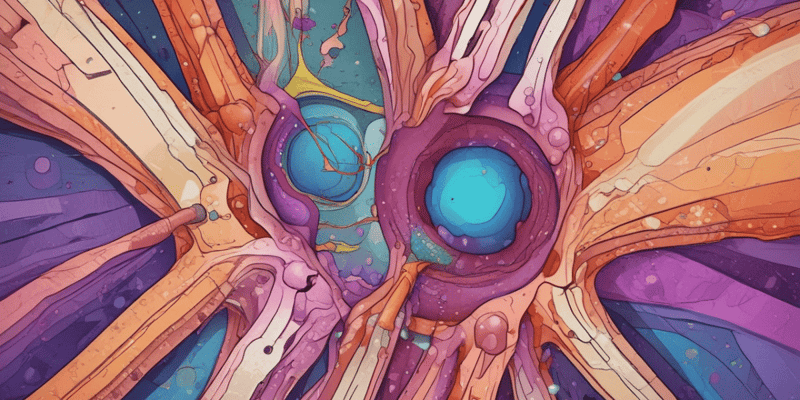Questions and Answers
What is the primary difference between regeneration and healing?
Regeneration replaces injured cells with same cell type, while healing replaces with fibrous tissue
What is the term for the process of scar formation in healing?
Fibroplasia
What is the term for the tissue that forms during the healing process?
Granulation tissue
What is the term for the process by which the liver regenerates?
Signup and view all the answers
What is the factor that controls tissue regeneration?
Signup and view all the answers
What is the term for the type of wound healing that involves the closure of the wound by the approximation of the wound edges?
Signup and view all the answers
Which of the following factors locally influences wound repair?
Signup and view all the answers
What is a systemic factor that inhibits collagen synthesis?
Signup and view all the answers
What is a consequence of persisting infection in a wound?
Signup and view all the answers
Which of the following is an example of a locally applied drug that influences wound repair?
Signup and view all the answers
What is a consequence of excessive movement on wound healing?
Signup and view all the answers
What is the primary reason for the recovery of tensile strength during the first 2 months of healing?
Signup and view all the answers
At later times, what contributes to the recovery of tensile strength?
Signup and view all the answers
What percentage of normal wound strength is typically reached by 3 months?
Signup and view all the answers
Why do permanent cells, such as neuronal cells, not recover after damage?
Signup and view all the answers
What is the consequence of damage to permanent cells, such as neurons and cardiac muscle cells?
Signup and view all the answers
What is the primary reason for the irreversibility of a stroke?
Signup and view all the answers
Which type of cells are responsible for carrying away debris during the wound healing process?
Signup and view all the answers
During which phase of wound healing do neutrophils disappear and macrophages enter the wound site?
Signup and view all the answers
What percentage of tensile strength of unwounded skin is achieved by the wound site in 3 months?
Signup and view all the answers
Which type of wound healing occurs when there is minimal or no skin loss?
Signup and view all the answers
What is the primary function of granulation tissue in wound healing?
Signup and view all the answers
When does the epidermis reach pre-incision thickness during the wound healing process?
Signup and view all the answers
What is the primary function of adhesive glycoproteins in the ECM?
Signup and view all the answers
What is the characteristic of granulation tissue during wound healing?
Signup and view all the answers
What is the primary component of the ECM that provides structural framework to the body?
Signup and view all the answers
What is the first step in the tissue healing process?
Signup and view all the answers
What is the purpose of collagen deposition during wound healing?
Signup and view all the answers
What is the final stage of wound healing in adults?
Signup and view all the answers
Study Notes
Healing and Regeneration
- Healing: replacement of injured cells by fibrous tissue, resulting in scar formation
- Regeneration: replacement of injured cells by cells of the same type, e.g., regeneration of skin or oral mucosa
Tissue Healing Process
- 8 steps:
- Inflammatory process induction
- Removal of damaged and dead tissue
- Migration and proliferation of connective tissue cells
- Formation of new blood vessels with granulation tissue
- Synthesis of extracellular matrix (ECM) and collagen deposition
- Tissue remodeling
- Wound contraction
- Acquisition of wound strength
Granulation Tissue
- Appearance: soft, beefy red, granular area that bleeds easily
- Characteristics: newly formed capillary blood vessels and fibroblasts
- Function: recovery of tensile strength results from excess collagen synthesis over collagen degradation during the first 2 months of healing
Stages of Wound Healing
- 4 continuous and overlapping phases:
- Haemostasis
- Inflammation
- Proliferation
- Remodeling
Healing by Primary and Secondary Intention
- Healing by primary union:
- Minimal or no skin loss
- Wound healing process occurs in 8 steps
- Tensile strength increases to 70-80% of unwounded skin in 3 months
- Healing by secondary union:
- Large tissue defects that need to be refilled
- Purulent infections prevent direct association of wound edges
- Granulation tissue generated to close dermal defect and transform into stable scar tissue
Factors Affecting Wound Healing
- Local factors:
- Size and site of the wound
- Persisting infection or foreign material
- Inadequate blood supply
- Excessive movement
- Irradiation
- Locally applied drugs
- Systemic factors:
- Age
- Nutritional deficiencies (e.g., vitamin C, zinc, protein)
- Metabolic diseases (e.g., renal failure, diabetes mellitus)
- Catabolic state associated with malignancies
- Systemic drugs
Studying That Suits You
Use AI to generate personalized quizzes and flashcards to suit your learning preferences.




